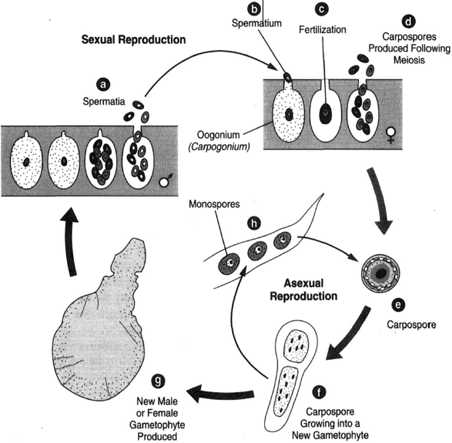Bangiophycidae
The Bangiophycidae subclass is the smaller of the two subclasses and probably the more primitive. Porphyra is an example of this subclass. In some species of Porphyra, the thallus is made of a single layer of cells: in others, there are two cell layers. Both asexual and sexual means of reproduction occur. In asexual reproduction, monospores are produced. These monospores may then grow into new plants. Sexual reproduction is more involved. Figure 15-1 shows a monostromatic (having only one cell layer) form of Porphyra. Any cell of the thallus can play the role of an antheridium and, by repeated divisions, produce up to 128 spermatia. Recall that there are no motile cells in red algae. Whereas motile male gametes are called sperm cells, nonmotile male gametes are called spermatia. Other cells on the same plant, or in other species on different plants, become oogonia, each bearing a single egg cell. A tubular emergence called a trichogyne develops from the oogonium to the exterior of the thallus. (The trichogyne also occurs among the Ascomycetes, a class of fungi.) For reasons that will soon become apparent, the oogonium can also be called a carpogonium.When the spermatia are released from the antheridium, they float around in the water. One or a few of the spermatia will come in contact with the trichogyne on the oogonium. A male nucleus may then make its way, by being drawn in through this receptive emergence, to the egg nucleus. Fusion then takes place followed promptly by meiosis and several mitotic divisions. The resulting nuclei are surrounded by cytoplasm and are then known as carpospores. Although carpospores in other examples may be diploid, these are haploid. Under favorable conditions, the carpospores may grow directly into new foliose plants. There is no alternation of generations. In some species, the carpospores are of two types: that half that produces male gametophytes and that half that produces female gametophytes.
When living conditions are less favorable, a different course of events may unfold. Instead of producing foliose plants, the growing carpospores produce minute plants that liberate monospores, which, in turn, may then form foliose plants.
 |
| Figure 15-1 A monostromatic form of Porphyra (a) spermatia; (b) an oogonium, or carpogonium, with spermatium at the end of the trichogyne; (c) fertilization. (d) Meiosis occurs and carpospores are produced. The carpospores grow into new gametophytes,( e), (f), and (g). At (h) an asexual pathway generates monospores, which can grow into new plants. |




